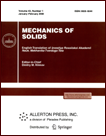 | | Mechanics of Solids
A Journal of Russian Academy of Sciences | | Founded
in January 1966
Issued 6 times a year
Print ISSN 0025-6544
Online ISSN 1934-7936 |
Archive of Issues
| Total articles in the database: | | 13362 |
| In Russian (»Á‚. –ņÕ. Ő““): | | 8178
|
| In English (Mech. Solids): | | 5184 |
|
| << Previous article | Volume 60, Issue 1 / 2025 | Next article >> |
| Haijing Wang, Weizhe Qiu, Hongyuan Wang, Jiahao Li, Xiaotian Li, Bo Zhou, Shifeng Xue, and Zhu Xiuxing, "A Machine Learning Method for Finite Element Stress Recovery Based on Feature Variables of Coordinate and Displacement," Mech. Solids. 60 (1), 720-736 (2025) |
| Year |
2025 |
Volume |
60 |
Number |
1 |
Pages |
720-736 |
| DOI |
10.1134/S0025654424606943 |
| Title |
A Machine Learning Method for Finite Element Stress Recovery Based on Feature Variables of Coordinate and Displacement |
| Author(s) |
Haijing Wang (College of Pipeline and Civil Engineering, China University of Petroleum (East China), Qingdao, 266580 China)
Weizhe Qiu (College of Pipeline and Civil Engineering, China University of Petroleum (East China), Qingdao, 266580 China)
Hongyuan Wang (College of Pipeline and Civil Engineering, China University of Petroleum (East China), Qingdao, 266580 China; Harbin Institute of Technology, Shenzhen, 518055 China)
Jiahao Li (College of Pipeline and Civil Engineering, China University of Petroleum (East China), Qingdao, 266580 China)
Xiaotian Li (College of Pipeline and Civil Engineering, China University of Petroleum (East China), Qingdao, 266580 China)
Bo Zhou (College of Pipeline and Civil Engineering, China University of Petroleum (East China), Qingdao, 266580 China, zhoubo@upc.edu.cn)
Shifeng Xue (College of Pipeline and Civil Engineering, China University of Petroleum (East China), Qingdao, 266580 China)
Zhu Xiuxing (College of Pipeline and Civil Engineering, China University of Petroleum (East China), Qingdao, 266580 China) |
| Abstract |
This paper proposes a novel machine learning method of finite element stress recovery,
which is based on the feature variables of coordinates and displacements, to improve stress recovery
accuracy. Four distinct machine learning algorithmsóBackpropagation (BP) Neural Network, Radial
Basis Function (RBF) Neural Network, Random Forest (RF), and Support Vector Regression
(SVR)óare applied to both linear and nonlinear stress fields using linear and quadratic finite elements. Results indicate that the proposed method achieves higher accuracy in recovering the three
node stress components compared to traditional methods, especially in small sample scenarios where
its advantages are more evident. For linear stress fields with limited samples and a higher prevalence
of outliers, the SVR algorithm demonstrated superior recovery performance, outperforming traditional finite element software. In contrast, for nonlinear stress fields with larger sample sizes and complex data relationships, the RBF Neural Network demonstrated the best recovery outcomes, also surpassing standard finite element software. Furthermore, quadratic elements consistently showed higher
stress recovery accuracy than linear elements. These findings offer valuable insights and practical
implications for enhancing stress recovery methods in finite element analysis. |
| Keywords |
Finite element method, Stress recovery, Machine learning, Feature variable |
| Received |
11 December 2024 | Revised |
17 January 2025 | Accepted |
09 February 2025 |
| Link to Fulltext |
|
| << Previous article | Volume 60, Issue 1 / 2025 | Next article >> |
|
 If you find a misprint on a webpage, please help us correct it promptly - just highlight and press Ctrl+Enter If you find a misprint on a webpage, please help us correct it promptly - just highlight and press Ctrl+Enter
|
|

 Russian
Russian  English
English